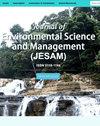Crown Fuel Characteristics and Allometric Equations of Pinus densiflora in Gyeongbuk Province, Korea
IF 0.3
4区 环境科学与生态学
Q4 ENVIRONMENTAL SCIENCES
引用次数: 0
Abstract
The crown fuel characteristics of the most dominant coniferous species in Korea, Pinus densiflora, were investigated in Gyeongbuk province, Korea. Allometric equations using DBH as independent variable were also developed for the estimation of crown fuel load (needles, branches: <0.5 cm, 0.5-1 cm, 1-2 cm, and 2-4 cm in diameter), crown volume, and aboveground biomass. The average crown bulk density in Youngju and Bonghwa was 0.47 kg m-3, while in Daegu, it was 0.29 kg m-3. The crown bulk density of needles and branches with a diameter of <1 cm was 0.21 kg m-3in Youngju, 0.27 kg m-3 in Bonghwa, and 0.13 kg m-3 in Daegu. The average crown base height was 5.10 m in Youngju, 5.20 m in Daegu, and 3.60 m in Bonghwa. Overall, the Pinus densiflora stand in Bonghwa is more hazardous if crown fire occurs compared to the other study sites based on different crown fuel characteristics. The allometric models developed were able to explain at least 79% of the observed variation in the biomass and crown volume. For the aboveground biomass, Daegu had the highest mean tree biomass with 103.54 kg, followed by Youngju (67.35 kg) and then Bonghwa (37.72 kg).韩国庆北省赤松树冠燃料特性及异速方程
对韩国最具优势的针叶树种松(Pinus densiflora)的树冠燃料特性进行了调查。以胸径为自变量建立了异速生长方程,用于估算树冠燃料负荷(针、枝:直径<0.5 cm、0.5-1 cm、1-2 cm和2-4 cm)、树冠体积和地上生物量。荣州和奉化的平均树冠容重为0.47 kg m-3,大邱为0.29 kg m-3。直径<1 cm的针和枝的树冠容重分别为荣州0.21 kg m-3、奉化0.27 kg m-3和大邱0.13 kg m-3。冠底平均高度分别为荣州5.10 m、大邱5.20 m、奉化3.60 m。总体而言,由于树冠燃料特性的不同,丰化松林分发生树冠火灾的危险性比其他研究地点更大。所建立的异速生长模型能够解释至少79%的观测到的生物量和树冠体积变化。地上生物量以大邱最高,为103.54 kg,其次是永州(67.35 kg)和奉化(37.72 kg)。
本文章由计算机程序翻译,如有差异,请以英文原文为准。
求助全文
约1分钟内获得全文
求助全文
来源期刊

Journal of Environmental Science and Management
ENVIRONMENTAL SCIENCES-
CiteScore
0.90
自引率
0.00%
发文量
10
审稿时长
2 months
期刊介绍:
The Journal of Environmental Science and Management (JESAM) is an international scientific journal produced semi-annually by the University of the Philippines Los Baños (UPLB).
JESAM gives particular premium to manuscript submissions that employ integrated methods resulting to analyses that provide new insights in environmental science, particularly in the areas of:
environmental planning and management;
protected areas development, planning, and management;
community-based resources management;
environmental chemistry and toxicology;
environmental restoration;
social theory and environment; and
environmental security and management.
 求助内容:
求助内容: 应助结果提醒方式:
应助结果提醒方式:


